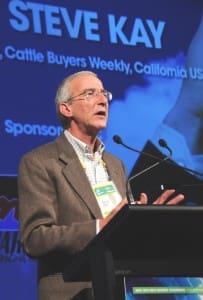 A monthly column written for Beef Central by US red meat industry commentator, Steve Kay, publisher of US Cattle Buyers Weekly
A monthly column written for Beef Central by US red meat industry commentator, Steve Kay, publisher of US Cattle Buyers Weekly
CATTLE producers in the United States, as I wrote in my June column, are fixated on a perceived lack of processing capacity in the beef industry.
They have persuaded the US Department of Agriculture and numerous members of Congress to take steps to provide more capacity.
So it’s especially ironic that separate moves to add new processing plants have suddenly become all the rage – moves that the three groups above have yet to acknowledge.
Another newly-formed beef company announced plans on June 23 to build a US$325 million beef processing plant in southwest Iowa. Cattlemen’s Heritage, an investor-owned corporation led by Chad Tentinger, plans to build a plant that will process 1500 head per day or 400,000 head per year.
Construction is set to begin next northern hemisphere spring. The plant is expected to employ 750 people when it begins operating in late 2023.
The company’s announcement follows a flurry of announcements earlier this year and last year about expansion plans at existing US beef plants, or plans for new facilities. Another new company, Sustainable Beef, announced in March its intention to build a new US$200 million, 1500 head per day plant in North Platte, Nebraska.
Fifth largest beef processor American Foods Group last month announced plans to build a new plant as well. Eight announcements since last August means that beef processing capacity will increase industry-wide by 6700 head per day if all the plans come to fruition. That is on top of about 135,000 head per day now.
The goal of Cattlemen’s Heritage is to help young farmers get started in the cattle business, says Chad Tentinger. The company expects to process cattle from Iowa, Nebraska and South Dakota, focussing on buying cattle from small, family-owned operations.
The company has no interest in buying its cattle from a couple of large feedlots. It wants as to buy cattle from as many producers as possible, he says.
Labour challenge
This goal is laudable. But it begs several questions that also apply to the proposed Sustainable Beef plant in Nebraska.
The first is: Where do these plants expect to get enough workers to fully operate their plants? I noted in my June column on Beef Central that lack of labour, not processing capacity, is what currently bedevils the US beef processing industry.
A labor shortage has been growing for several years and the COVID-19 pandemic exacerbated the shortage. Workers left their jobs and despite packers raising starting wages to US$22 per hour and offering signing bonuses and even free college tuition for workers’ children (as JBS USA has done), many workers decided not to return to their old jobs.
The result is that many US beef, pork and poultry plants are running 10pc to 15pc below capacity, as Tyson Foods disclosed in May.
Drought impact
My second question relates to supply. Live cattle numbers currently remain ample. The June 1 Cattle on Feed total was up only 0.2pc on a year ago. But it was the second largest June 1 number in USDA’s data series.
That will change going forward mainly because of the severe drought that is getting worse by the week across more of the US. By the time new plants come on stream, the available fed cattle supply might be one million head less than today because of herd liquidation this year and in 2022 and 2023.
That is more than what the two new plants would harvest annually. As much as these plants hope small cattle feeders will support them, the reality is that existing players, national or regional, will do their utmost to outbid them for the best cattle.
My third question relates to beef marketing. Nowhere have I seen any mention by the two newly-formed companies of what kind of beef products they intend to produce and how they might differentiate them from the beef produced weekly by existing players.
These players still produce largely commodity beef. But they also have dozens of value-added, branded beef programs that are well-established. These programs provide double-digit operating margins that are far above commodity beef margins. How will the new firms compete with all this?
Veteran meat marketing guru Mack Graves in a recent article made several highly pertinent comments on the topic.
“My fundamental problem with the hunger for more capacity is that the new folks and some of the old proposing to convince investors to support their “build it and they will come” desires, start and end with cattle slaughter/processing,” he said.
“Beef marketing is almost an afterthought. As I review the business rationale stated for the new plants, it is that is the big boys are screwing us, and we aren’t going to take it anymore – so we’ll build our own plants that will be more efficient.”
The beef industry is dominated by the production side of the house, says Graves, with little resources being applied to beef marketing in forms unimagined today but needed for the industry to grow and prosper in the face of continued chicken expansion and alt-meat products’ market incursions.
His concern is that the plant building spree will only result in exacerbated over-capacity, resulting in those who are under-capitalised from the get-go losing money faster than they can count it. And cattle producers lose again, he says.
I agree with Graves, as that has already occurred several times in the US in the past 20 years.



HAVE YOUR SAY